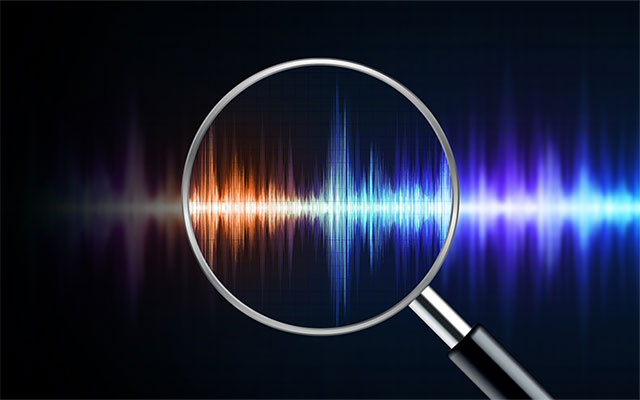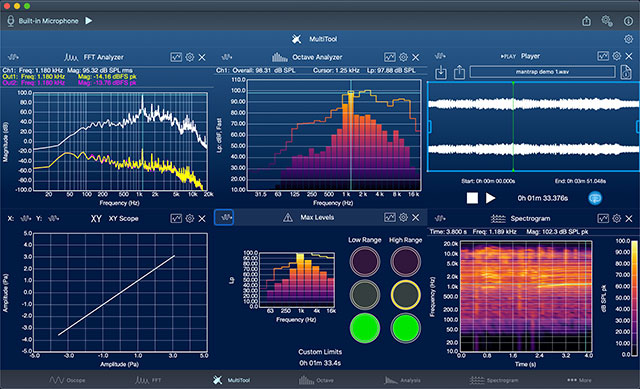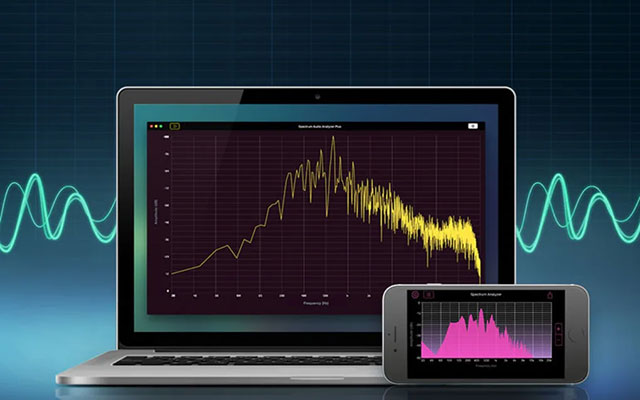 Audio Analyzers are software tools used to analyze various aspects of audio files. These tools can provide users with a comprehensive understanding of the technical characteristics of their audio files. This can help professionals in multiple fields, including music production, sound engineering and broadcasting, to ensure that their audio is of the highest quality. Audio Analyzers are used to analyze different aspects of an audio file, including frequency response, dynamic range and distortion.
Audio Analyzers are software tools used to analyze various aspects of audio files. These tools can provide users with a comprehensive understanding of the technical characteristics of their audio files. This can help professionals in multiple fields, including music production, sound engineering and broadcasting, to ensure that their audio is of the highest quality. Audio Analyzers are used to analyze different aspects of an audio file, including frequency response, dynamic range and distortion.
Click here to try our free online Audio File Analyzer.
In today's world, audio is everywhere. From music and movies to podcasts and webinars, audio plays an essential role in communicating, entertaining and informing. As a result, the quality of audio has become increasingly important. Audio Analyzers can help ensure that audio quality is consistent, accurate and reliable. By using these tools, professionals can identify issues with their audio files, which may not be audible to the human ear. This allows them to make the necessary adjustments to improve the overall quality of the audio.
The use of Audio Analyzers dates back to the early days of radio broadcasting. In the early 1930s, the first Audio Analyzers were developed to help engineers analyze the performance of radio transmitters. These early devices were rudimentary and could only measure a few parameters. However, as technology advanced, so did Audio Analyzers. Today's Audio Analyzers are powerful tools capable of analyzing many parameters, including frequency response, distortion and noise.
As the demand for high-quality audio has increased, so has the need for accurate and reliable Audio Analyzers. Today, Audio Analyzers are used in various fields, including music production, sound engineering and broadcasting. They are an essential tool for professionals who require precise and accurate measurements of their audio files.
An audio file analyzer is a software tool that allows you to analyze your audio files in-depth. Audio file analyzers can give you detailed information about every aspect of your audio files, which is incredibly useful for musicians, sound engineers and other professionals in the audio industry.
Audio file analyzers examine the digital data contained within your audio files. They use complex algorithms to analyze the audio data's amplitude, frequency and other characteristics. This lets them provide a wealth of information about your audio files.
 Audio file analyzers typically analyze three categories of data for your audio files: File Summary, File Detail and Channel Detail. Each of these categories provides different information about your audio files.
Audio file analyzers typically analyze three categories of data for your audio files: File Summary, File Detail and Channel Detail. Each of these categories provides different information about your audio files.
The File Summary category provides an overview of the main elements of your audio files, including the number of channels, sample and bit rates, bit depth, file size and length and metadata tags, if any.
The File Detail category provides more detailed information about your audio files. This includes information such as the length of the audio file in seconds, the maximum and minimum sample values, the arithmetic mean of sample values and the root mean square of the sample values.
The File Detail category also provides the maximum and minimum difference between two successive samples, the estimation of the input file's frequency in hertz and the value that should be sent to peak absolute amplitude.
The Channel Detail category provides detailed information about the individual channels in your audio files. This includes information such as the DC offset, minimum and maximum levels, peak and RMS levels measured in dBFS and the peak and trough values for RMS levels measured over a short window.
Other information provided by the Channel Detail category includes the standard ratio of peak to RMS level, a measure of the flatness of the signal at its peak levels and the number of times the signal reached either the minimum or maximum level.
The File Summary category provides a high-level overview of your audio files, making it a valuable tool for rapidly assessing the general characteristics of your audio files. This information can be beneficial when working with large numbers of audio files and identifying specific files quickly.
The File Detail category provides more detailed information about your audio files, which is handy for audio engineers and other professionals who need to work with audio data at a more granular level. This information can be used to identify specific issues with your audio files, such as clipping or distortion.
The Channel Detail category provides detailed information about the individual channels in your audio files, making it a valuable tool for identifying specific issues with those channels. This information can be beneficial when working with multichannel audio files, such as those used in surround sound systems.
Overall, audio file analyzers provide a powerful tool for analyzing and understanding your audio files. By combining File Summary, File Detail and Channel Detail analysis, you can gain a deep understanding of your audio files and identify specific issues that need to be addressed.
 When analyzing an audio file, Audio File Analyzers break down the file into three categories of data: File Summary, File Detail and Channel Detail. The File Summary category provides an overview of the main elements of your audio files. This includes essential information such as the number of channels, sample and bit rates, bit depth, file size and length and metadata tags.
When analyzing an audio file, Audio File Analyzers break down the file into three categories of data: File Summary, File Detail and Channel Detail. The File Summary category provides an overview of the main elements of your audio files. This includes essential information such as the number of channels, sample and bit rates, bit depth, file size and length and metadata tags.
Overall, the File Summary category provides essential information about the main elements of an audio file, which can be used to evaluate the quality and characteristics of the audio.
File analysis is a critical process Audio File Analyzers use to provide detailed statistics about your audio files. These statistics include various parameters for assessing audio files' quality and characteristics. File Detail analysis offers detailed information about the audio files' amplitude, frequency and other critical aspects.
The following are the detailed statistics provided by File Detail analysis:
Overall, File Detail analysis provides vital information about audio files' amplitude, frequency and other critical aspects. These statistics help determine an audio file's dynamic range, frequency content and overall quality.
Channel analysis provides specific statistics about each channel in an audio file. This analysis category helps identify and address issues related to individual channels, such as imbalances or distortions. Channel Detail analysis can also be used to compare the characteristics of different channels within a file, such as stereo channels or multi-track recordings.
Audio analyzers come in various types, each with unique features and applications. Below are some of the most common types of audio analyzers used in the industry.
Real-time audio analyzers are designed to provide instant feedback on audio performance and are used for live events, recording studios, and sound reinforcement systems. They analyze audio signals as they occur and display the results in real time. This type of audio analyzer is ideal for monitoring live audio signals and can help detect problems before they become audible.
 Offline audio analyzers are used to analyze audio files that have already been recorded. They are ideal for audio engineers who want to study audio files in post-production. Unlike real-time audio analyzers, offline audio analyzers take their time to analyze audio files and provide more detailed information about the audio file. These are often standalone software tools you can install to analyze audio files on your computer. They usually offer a wide range of features and customization options.
Offline audio analyzers are used to analyze audio files that have already been recorded. They are ideal for audio engineers who want to study audio files in post-production. Unlike real-time audio analyzers, offline audio analyzers take their time to analyze audio files and provide more detailed information about the audio file. These are often standalone software tools you can install to analyze audio files on your computer. They usually offer a wide range of features and customization options.
Web-based tools allow you to upload your audio files to a server and analyze them remotely. They are usually simpler and more streamlined than offline analyzers. Click here to check out our free online Audio File Analyzer.
There are also several audio file analyzer apps available for smartphones and tablets. These apps are usually simpler and more streamlined than standalone analyzers, but they can help analyze audio on the go.
Audio file analyzer plugins are add-ons for audio editing software such as Adobe Audition, Audacity and Pro Tools. They offer a convenient way to analyze audio files within your editing environment.
Spectrum analyzers are used to analyze the frequency content of an audio signal. They display the frequency spectrum of the audio signal as a graph. Spectrum analyzers determine a device's frequency response and identify and eliminate feedback and unwanted noise.
Loudness meters are used to measure the perceived loudness of an audio signal. They measure loudness in LUFS (Loudness Units Full Scale) and are used to ensure that the loudness of an audio signal complies with various broadcast standards. Loudness meters are essential for ensuring that audio signals are not too loud or too quiet.
Acoustic analyzers are used to measure the acoustic properties of a room. They measure room acoustics, such as reverb time, early reflections and frequency response. These analyzers ensure a space is acoustically suitable for recording or live sound applications.
Overall, the type of audio analyzer suitable for a particular application depends on the application's specific requirements. Choosing the right audio analyzer for the task at hand is essential to ensure accurate and reliable results.
Audio analyzers are essential for music, broadcasting and live sound professionals. They analyze, measure and optimize audio signals and provide detailed information about the audio files. Here are some of the applications of audio analyzers:
 Audio analyzers are widely used in the professional audio recording industry. Recording engineers use audio analyzers to analyze and optimize the sound quality of recordings. They use analyzers to measure various aspects of the audio signal, such as frequency response, distortion, noise and dynamic range. The information provided by audio analyzers helps engineers make informed decisions about recording equipment, microphone placement and other recording techniques.
Audio analyzers are widely used in the professional audio recording industry. Recording engineers use audio analyzers to analyze and optimize the sound quality of recordings. They use analyzers to measure various aspects of the audio signal, such as frequency response, distortion, noise and dynamic range. The information provided by audio analyzers helps engineers make informed decisions about recording equipment, microphone placement and other recording techniques.
Audio analyzers are also used in the broadcast industry to ensure that audio signals meet broadcasting standards. In broadcast applications, audio analyzers measure loudness, peak level, frequency response and other audio parameters. They help engineers to ensure that audio signals are optimized for transmission and provide the best possible listening experience for the audience.
In live sound reinforcement, audio analyzers are used to measure and optimize the sound quality of live performances. Sound engineers use audio analyzers to measure room acoustics, frequency response and other audio parameters to optimize sound quality for the audience. Audio analyzers help eliminate feedback, reduce distortion, and ensure the sound system delivers the best possible audio quality.
Audio analyzers are also helpful for home audio enthusiasts who want to optimize the sound quality of their audio systems. Audio analyzers can help users measure room acoustics, frequency response and other audio parameters to ensure that the audio system delivers the best sound quality.
Audio analyzers are also helpful for educational and research purposes. They provide detailed information about audio signals, which can be used to research and teach audio-related subjects. Audio analyzers can help students and researchers understand how audio signals work, how to measure audio parameters and optimize audio systems for different applications.
Overall, audio analyzers are essential for professionals and enthusiasts in the music, broadcasting and live sound industries. They provide detailed information about audio signals, which can be used to optimize sound quality and ensure that audio signals meet broadcasting standards. Audio analyzers are also helpful for home audio enthusiasts, education and research purposes.
Audio analyzers are powerful tools for analyzing and optimizing audio performance. To get the most out of your analyzer, following some best practices is essential.
Calibration is crucial in ensuring that your analyzer provides accurate measurements. Calibration involves comparing the output of your analyzer to a known standard and adjusting the analyzer's settings if necessary to ensure that it's correct.
You'll need a calibration source to calibrate your analyzer, a device that produces a known, stable signal. The most common calibration source for audio analyzers is a pink noise generator. You can also use a sine wave generator or a calibrated microphone.
Once you have your calibration source, follow the instructions provided with your analyzer to perform the calibration. Make sure to calibrate your analyzer regularly to ensure that it remains accurate.
Noise can interfere with your analyzer's measurements, particularly in environments with high ambient noise. To reduce the impact of noise, consider using noise reduction techniques such as:
Many types of audio analyzers are available, each with strengths and weaknesses. To choose the correct analyzer for your needs, consider the following:
You can get the most accurate and useful measurements by choosing the right audio analyzer and following best calibration and noise reduction practices.
In conclusion, audio analyzers play an integral role in the audio industry by providing professionals and home recording artists with precise measurements and analyses of audio signals. They enable the identification and resolution of issues affecting the quality of audio recordings, broadcasts and live performances. Additionally, they aid in optimizing and troubleshooting audio systems to achieve better sound quality.
As technology advances, so do audio analyzers. There is a growing trend towards digital and wireless audio systems, which require more complex analysis tools to ensure optimal performance. Furthermore, there is increasing demand for analyzers that can examine multi-channel and immersive audio formats, such as Dolby Atmos and DTS:X. As these technologies become more widespread, the need for advanced audio analysis tools will only continue to increase.
Furthermore, the use of audio analyzers is not limited to the professional audio industry but can also be beneficial in everyday life. For instance, it can help individuals to analyze and optimize their home audio systems, ensuring a more enjoyable listening experience. As such, the importance of audio analyzers will continue to grow, making them essential tools for anyone who wants to improve the quality of their audio signals.